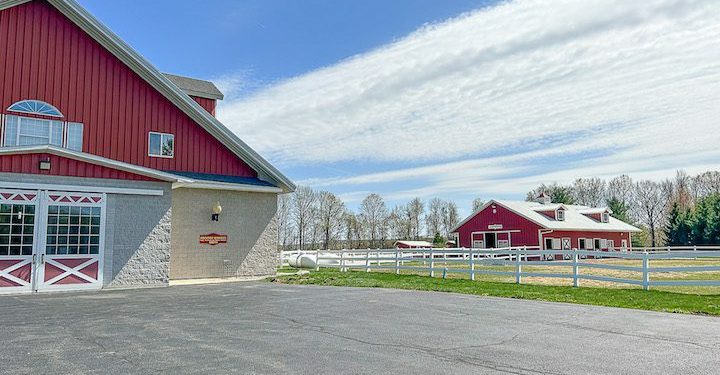ALTAMONT — Taylor Huntley, Executive Director, Program Director, and PATH International Certified Therapeutic Riding Instructor, describes the Albany Therapeutic Riding Center Inc. (ATRC) as a “safe space” for everyone.
Great attention is paid to providing an inclusive, safe atmosphere that meets everyone’s needs, from the saddle chosen to the reins held and the horse that will guide the journey.
The ATRC’s mission of providing assisted programming to everyone remains unchanged since it was founded in 1981 by Christine Lehman. After running ATRC on Lehman’s family farm in Voorheesville for almost 37 years, Huntley joined the team in 2018, and she continues to guide the program forward into the future.
The farm has seven horses that are each unique in their personalities and abilities. A beloved horse on the farm named Jane glides efficiently through her sessions with an experience that puts beginners at ease.
A quarter horse named Luke is an intuitive companion for social and emotional lessons. Apollo’s small, narrow stature inclines Huntley to recommend him for riders who have hypertonicity or spasticity in their lower body.
“It takes an exceptional horse to be a therapeutic riding horse,” said Huntley.
Huntley incorporates both mounted and ground work into the lessons. On horseback, Huntley noted that “the movement is similar to the human gait and therefore may enable the use of muscles that might not be engaged on a regular basis.”
She added, “We love supporting people who might not otherwise be able to access a social or recreational program to enjoy therapeutic horseback riding. People with a wide range of challenges may be aided by therapeutic horseback riding.”

Some of the positive benefits Huntley has noticed in the riding students have included improvements in walking and talking and an increased sense of self-confidence.
“Participants may experience increased core strength, increased balance and stabilization of their gait, improved fine and gross motor skills, problem solving skills, better direction following, increased social and communication skills, and improved mental health,” said Huntley.
Every lesson is tailored to each participant’s specific needs based on an in-depth assessment with the support of conversations with their family, guardians, and support staff in their lives.
“That helps us to develop an idea of what kind of lesson will be best for them, whether it is mounted therapeutic riding or unmounted,” said Huntley, “and what horse and instructor will be most appropriate.”
At the ATRC, there is no strict agenda. Each session is guided through personalized steps forward that are built on a foundation of trust between the person and their horse.
Jasmin Raidoo, a licensed clinical social worker and psychotherapist, is also using horses as a therapeutic tool at Changing Reins Psychotherapy in Saratoga Springs. She and Huntley met as young women boarding horses at the same farm. Now, they collaborate on the same equine-assisted therapy mission.
Raidoo’s program is considered outpatient therapy. While she also provides indoor sessions, a key aspect of her work takes place outdoors with the horses or her therapy dogs.
She specializes in trauma work, specifically trauma-focused equine-assisted therapy. Unlike Huntley’s program, Raidoo doesn’t have any mounted work. Instead, she focuses on interactions with the horses on the ground.
“Essentially, we are two programs that offer interactions with horses, but the key difference is therapeutic goals and how we use horses to reach those goals,” said Raidoo.
Raidoo’s work centers on self-regulation, breathwork, learning coping skills, and using the horses as an opportunity to talk about behavior and interactions.
Studies show that interactions with animals can decrease cortisol levels and increase serotonin in the body. The HeartMath Institute and the Natural Lifemanship Institute post research information about the neurobiology of horses and humans, specifically for trauma work. The University of Denver remains a pioneer in educating practitioners about animal-assisted therapy.
Equine therapy is practiced more widely in western and southern parts of the United States.
“I do think in the Northeast, it will become a more prevalent modality,” said Raidoo. “I hope it continues to grow and be more accessible for the general public, but for the general public, it is important to know where you’re going and that you’re still working with licensed clinicians.”
Raidoo said equine-assisted psychotherapy is research-based and follows specific medical guidelines. The ATRC is a member center of the Professional Association of Therapeutic Horsemanship International (PATH). PATH provides guidelines and standards for best practice and safety for all mounted and unmounted horsemanship.
“It’s so important for me to stress that, because there are a lot of programs out there that advertise help through horses without having a clinical background, ethical practices or the research to support them,” added Raidoo.
She said horses can be such a wonderful asset to treatment when used in the correct way.
As Huntley focuses on short-term and long-term goals in the background of each lesson, she’s noticed how benefits tend to naturally follow the process with time and trust.
“My favorite part of what I do is talking to each participant’s loved ones about how their horsemanship lessons are impacting their everyday lives,” she said.
“All of this comes from the 30 minutes to an hour they spend at the barn weekly, and it is impacting every moment of every day,” said Huntley. “My office is decorated with drawings of all of our horses made by the participants who were impacted by our four-legged staff members the most. Every day we see new and exciting ways that therapeutic riding has affected our participants’ lives.”



